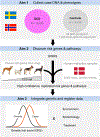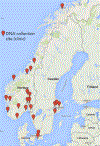Nordic OCD & Related Disorders Consortium: Rationale, design, and methods
- PMID: 31424634
- PMCID: PMC6898732
- DOI: 10.1002/ajmg.b.32756
Nordic OCD & Related Disorders Consortium: Rationale, design, and methods
Abstract
Obsessive-compulsive disorder (OCD) is a debilitating psychiatric disorder, yet its etiology is unknown and treatment outcomes could be improved if biological targets could be identified. Unfortunately, genetic findings for OCD are lagging behind other psychiatric disorders. Thus, there is a pressing need to understand the causal mechanisms implicated in OCD in order to improve clinical outcomes and to reduce morbidity and societal costs. Specifically, there is a need for a large-scale, etiologically informative genetic study integrating genetic and environmental factors that presumably interact to cause the condition. The Nordic countries provide fertile ground for such a study, given their detailed population registers, national healthcare systems and active specialist clinics for OCD. We thus formed the Nordic OCD and Related Disorders Consortium (NORDiC, www.crowleylab.org/nordic), and with the support of NIMH and the Swedish Research Council, have begun to collect a large, richly phenotyped and genotyped sample of OCD cases. Our specific aims are geared toward answering a number of key questions regarding the biology, etiology, and treatment of OCD. This article describes and discusses the rationale, design, and methodology of NORDiC, including details on clinical measures and planned genomic analyses.
Keywords: Denmark; GWAS; Norway; OCD; Sweden; genetic.
© 2019 Wiley Periodicals, Inc.
Conflict of interest statement
Financial Disclosures
The authors report no biomedical financial interests or potential conflicts of interest.
Figures



References
-
- Agerbo E, Sullivan PF, Vilhjalmsson BJ, Pedersen CB, Mors O, Borglum AD,… Mortensen PB (2015). Polygenic Risk Score, Parental Socioeconomic Status, Family History of Psychiatric Disorders, and the Risk for Schizophrenia: A Danish Population-Based Study and Meta-analysis. JAMA psychiatry, 72(7), 635–641. doi:10.1001/jamapsychiatry.2015.0346 - DOI - PubMed
-
- American Psychiatric Association. (2013). Diagnostic and statistical manual of mental disorders (5th ed.). Arlington, VA: American Psychiatric Publishing.
-
- Axelsson O (2003). The Swedish medical birth register. Acta Obstet Gynecol Scand, 82(6), 491–492. - PubMed
Publication types
MeSH terms
Grants and funding
LinkOut - more resources
Full Text Sources
Medical

